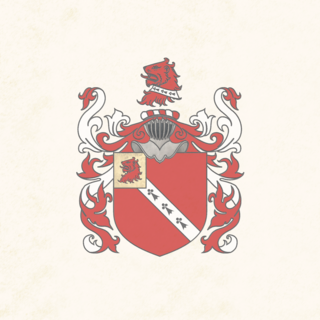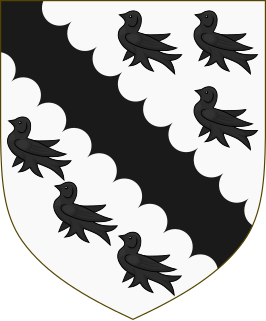There have been three baronetcies created for descendants of the ancient Lancashire family of Gerard.

There have been four baronetcies created for members of the Acland family, which originated in the 12th century at the estate of Acland in the parish of Landkey, North Devon, two in the Baronetage of England and two in the Baronetage of the United Kingdom.
Nineteen baronetcies have been created for persons with the surname Hamilton, eight in the Baronetage of Nova Scotia, one in the Baronetage of England, five in the Baronetage of Ireland, one in the Baronetage of Great Britain and four in the Baronetage of the United Kingdom. As of 2008 two creations are extant, two are dormant, two are either extinct or dormant and twelve extinct.

The Jerningham Baronetcy, of Cossey in the County of Norfolk, was a title in the Baronetage of England. It was created on 16 August 1621 for Henry Jerningham. The 5th Baronet married Mary Plowden, only daughter of Mary Plowden, sister of John Paul Stafford-Howard, 4th Earl of Stafford and de jure 5th Baron Stafford. He was succeeded by his son, the sixth Baron. In 1807 the claim to the barony of Stafford, which had been under attainder since 1680, passed to him through his mother. He died in 1809 when the baronetcy and the claim to the barony passed to his son, the seventh Baronet. He petitioned the House of Lords for a reversal of the attainder of the barony of Stafford and for a writ of summons to Parliament. In 1824 the attainder was reversed and the following year he was summoned to the House of Lords as the eighth Baron Stafford.
Three baronetcies were created for persons with the surname D'Oyly, two in the Baronetage of England and one in the Baronetage of the United Kingdom. One creation is extant as of 2008.
There have been two baronetcies created for members of the Boughton, later Rouse-Boughton family, one in the Baronetage of England and one in the Baronetage of Great Britain.

There have been two Charlton Baronetcies:-

The Milbanke, later Noel, later Milbanke Baronetcy, of Halnaby in the County of York, was a title in the Baronetage of England. It was created on 7 August 1661 for Mark Milbanke. His father was Mark Milbanke of Chirton, Northumberland a Newcastle on Tyne merchant and hostman who was Sheriff of the city in 1638, and Mayor in 1658 and 1672, and whose marriage brought him an estate at Halnaby, near Darlington, North Yorkshire. The second Baronet was High Sheriff of Northumberland in 1678. The third Baronet was High Sheriff of Northumberland 1685 and Member of Parliament for Richmond. The fifth Baronet was Member of Parliament for Scarborough and Richmond. The sixth Baronet sat as Member of Parliament for County Durham. He married Judith Noel and changed his surname in 1815, but he died leaving only a daughter, Annabella, who married the poet Lord Byron, and so he was succeeded by his nephew. The tenth Baronet was awarded the Victoria Cross. The title became extinct on the death of the twelfth Baronet in 1949.
There have been five baronetcies created for members of Clan Ramsay, four in the Baronetage of Nova Scotia and one in the Baronetage of the United Kingdom. The baronetcy in the Baronetage of the United Kingdom is extant as of 2021.

There have been three baronetcies created for descendants of the ancient Norman family of Molyneux who were granted extensive estates in Lancashire after the Norman Conquest.
The Baronetcy of Goodricke of Ribston was created in the Baronetage of England by King Charles I on 14 August 1641 for his loyal supporter John Goodricke of Ribston, Yorkshire. He represented Yorkshire in the Cavalier Parliament from 1661 to his death.
The Bland Baronetcy, of Kippax Park in the County of York, was a title in the Baronetage of England. It was created on 30 August 1642 for Thomas Bland, of Kippax Park, near Leeds, Yorkshire, in honour of his father's service to King Charles I. The third Baronet succeeded his father as an infant, died at the age of five and was succeeded by his brother who was Member of Parliament for Appleby 1681 and for Pontefract 1698–1713. The fifth Baronet represented Lancashire 1713–27 and the sixth Baronet served as member for Ludgershall 1754–5. His brother succeeded in 1755 but died in 1756, at which time the baronetcy became extinct.

Two unrelated baronetcies have been created in the surname of Clifton.
The Vernon family was a wealthy, prolific and widespread English family with 11th-century origins in Vernon, Normandy, France. Their extant titles include Baron Vernon and Vernon baronets of Shotwick Park.

The Tempest family was an English recusant family that originated in western Yorkshire in the 12th century.
There have been two baronetcies granted to the Willises of Fen Ditton, both in the Baronetage of England. The Willis Baronetcy, of Fen Ditton in Cambridgeshire, was first created in the Baronetage of England on 15 December 1641 for Thomas Willis, son and heir of Inner Temple barrister and landowner Richard Willys, of Fen Ditton and Horningsey, Cambridgeshire, by Jane, daughter and heir of William Henmarsh, of Ball's Park, in Ware, Hertfordshire. Richard's brother, Thomas, was Clerk of the Crown in Chancery.
Sir Roger Meredith, 5th Baronet was an English politician who sat in the House of Commons from 1727 to 1734.
Sir John Duke, 2nd Baronet was an English politician who sat in the House of Commons variously between 1679 and 1698.

Sir John Fowell, 3rd Baronet of Fowelscombe in the parish of Ugborough in Devon, was an English politician who sat in the House of Commons from 1689 to 1692.
Sir Robert Thomas, 2nd Baronet (c.1622-1685) was a Welsh politician who sat in the House of Commons of England from 1661 to 1681. He was knighted and succeeded as baronet in 1673 on the death of his father.








